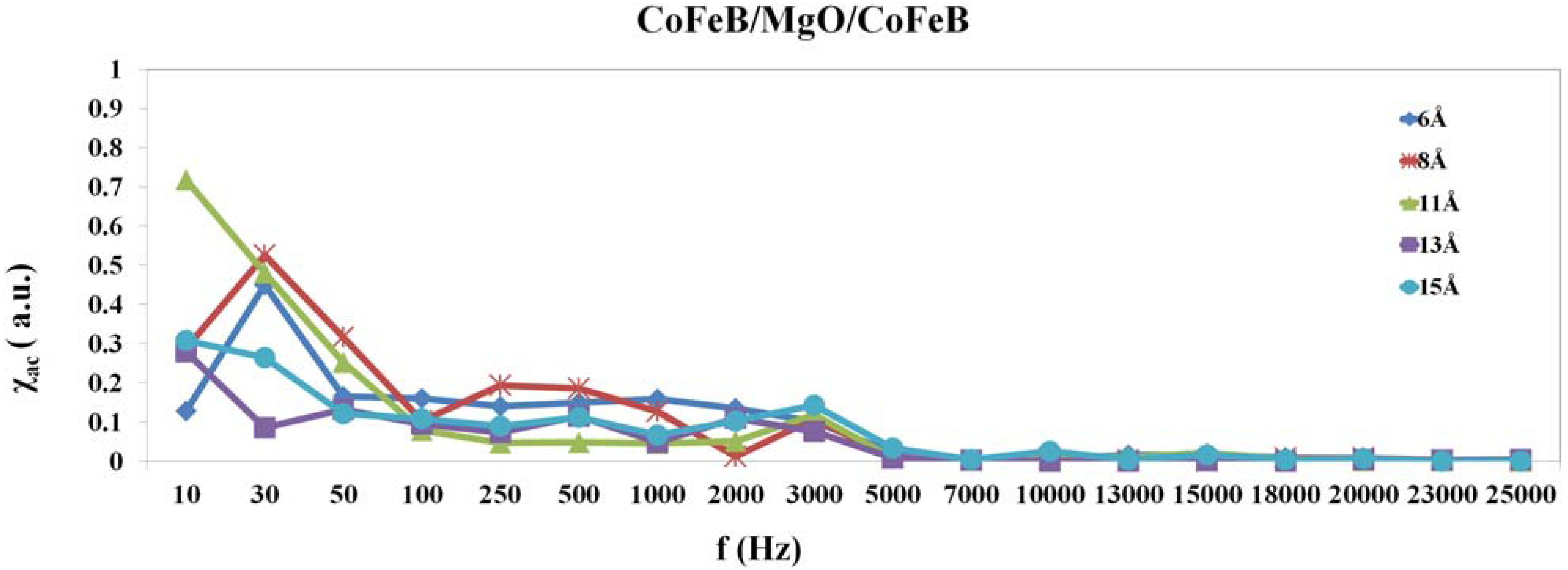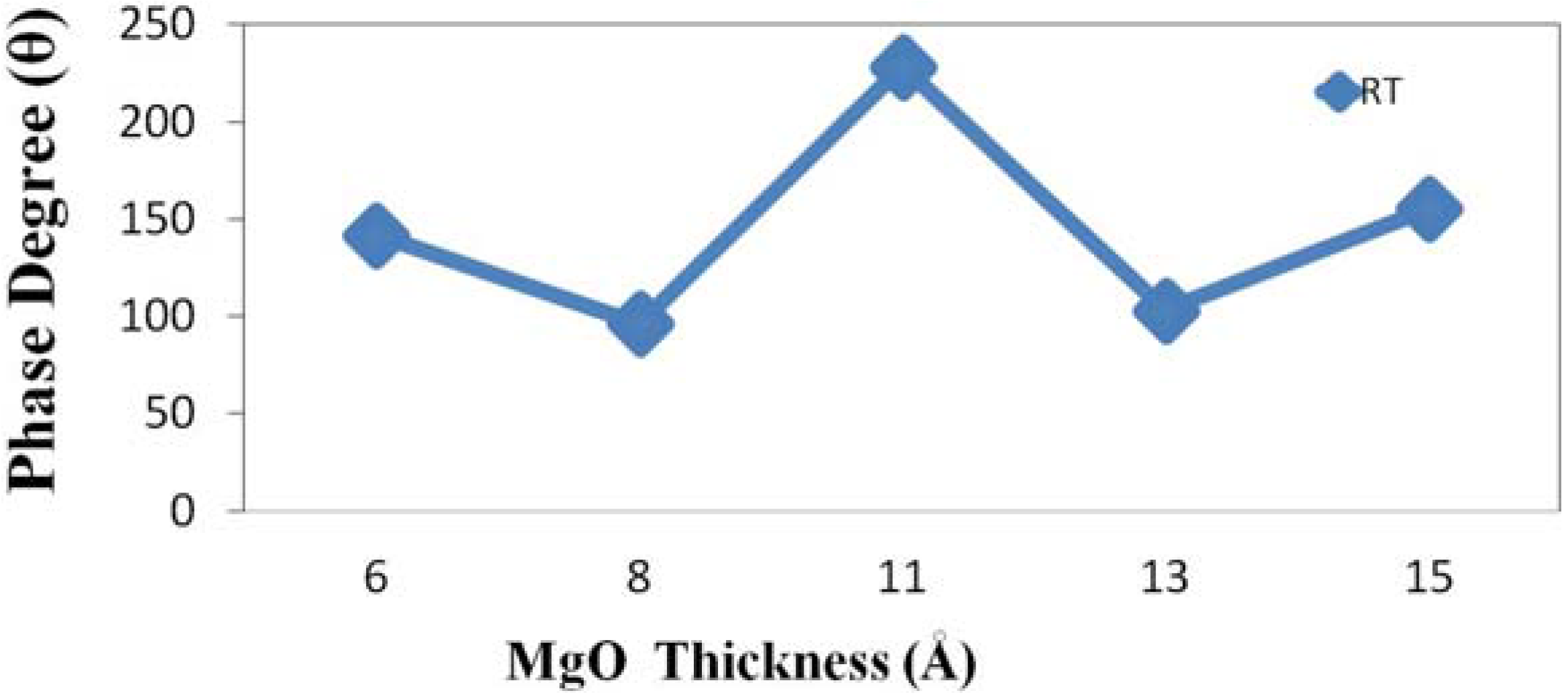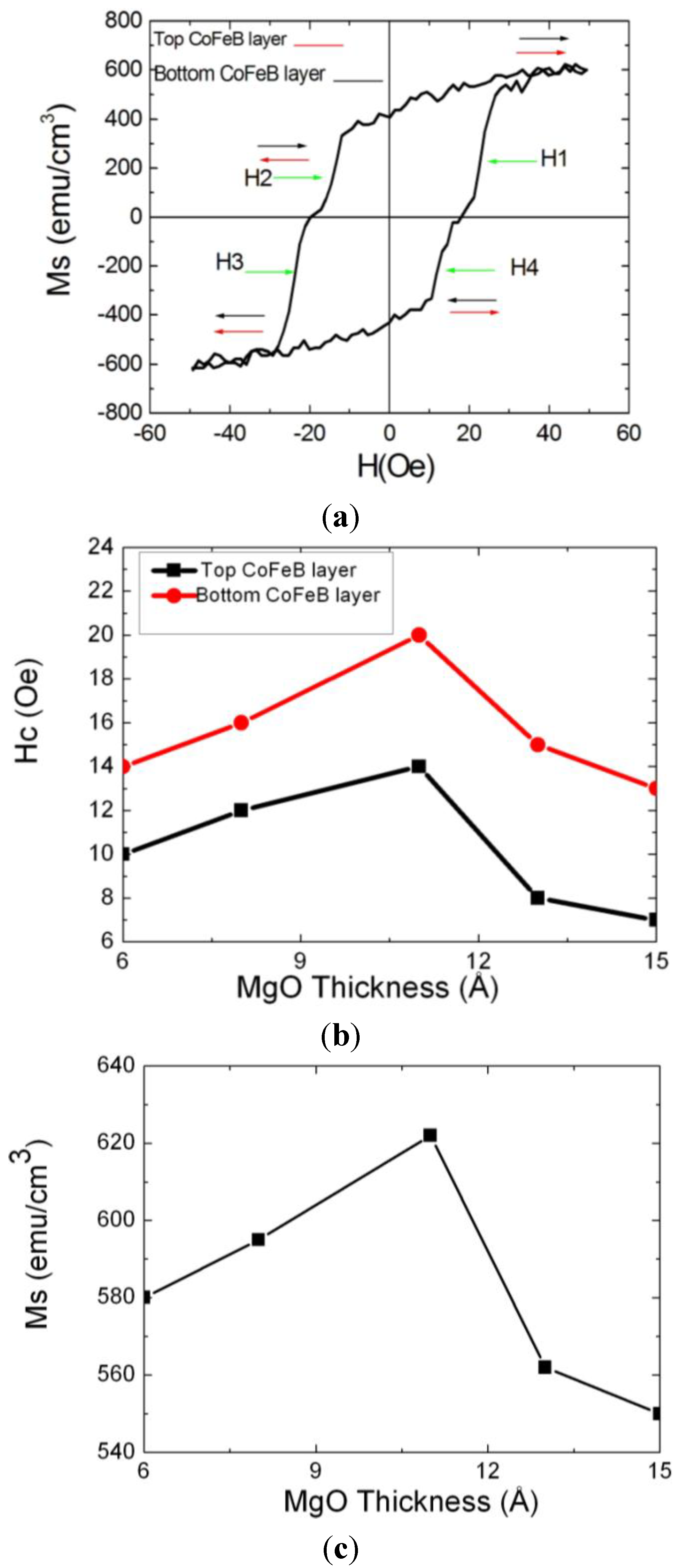Effect of Low-Frequency AC Magnetic Susceptibility and Magnetic Properties of CoFeB/MgO/CoFeB Magnetic Tunnel Junctions
Abstract
:1. Introduction
2. Results and Discussion



| MgO (Å) | Maximum χac (a.u.) | Maximun phase angle θmax (degree) | Highest χac corresponding optimal resonance frequency fres (Hz) |
|---|---|---|---|
| 6 Å | 0.44 | 142.24 | 30 Hz |
| 8 Å | 0.52 | 96.44 | 30 Hz |
| 11 Å | 0.71 | 228.59 | 10 Hz |
| 13 Å | 0.27 | 103.47 | 10 Hz |
| 15 Å | 0.30 | 155.44 | 10 Hz |

3. Experimental Section
4. Conclusions
Acknowledgements
Conflicts of Interest
References
- Miyazaki, T.; Tezuka, N. Giant magnetic tunneling effect in Fe/Al2O3/Fe junction. J. Magn. Magn. Mater. 1995, 139, L231–L234. [Google Scholar]
- Moodera, J.S.; Kinder, L.R.; Wong, T.M.; Meservey, R. Large magnetoresistance at room temperature in ferromagnetic thin film tunnel junctions. Phys. Rev. Lett. 1995, 74, 3273–3276. [Google Scholar] [CrossRef]
- Katayama, T.; Yuasa, S.; Velev, J.; Zhuravlev, M.Y.; Jaswal, S.S.; Tsymbal, E.Y. Interlayer exchange coupling in Fe/MgO/Fe magnetic tunnel junctions. Appl. Phys. Lett. 2006, 89, 112503:1–112503:3. [Google Scholar]
- Zhuravlev, M.Y.; Tsymbal, E.Y.; Vedyayev, A.V. Impurity-assisted interlayer exchange coupling across a tunnel barrier. Phys. Rev. Lett. 2005, 94, 026806:1–026806:4. [Google Scholar]
- Matsumoto, R.; Hamada, Y.; Mizuguchi, M.; Shiraishi, M.; Maehara, H.; Tsunekawa, K.; Djayaprawira, D.D.; Watanabe, N.; Kurosaki, Y.; Nagahama, T.; et al. Tunneling spectra of sputter-deposited CoFeB/MgO/CoFeB magnetic tunnel junctions showing giant tunneling magnetoresistance effect. Solid State Commun. 2005, 136, 611–615. [Google Scholar] [CrossRef]
- Aoki, T.; Ando, Y.; Watanabe, D.; Oogane, M.; Miyazaki, T. Spin transfer switching in the nanosecond regime for CoFeB/MgO/CoFeB ferromagnetic tunnel junctions. J. Appl. Phys. 2008, 103, 103911:1–103911:4. [Google Scholar]
- You, C.Y.; Goripati, H.S.; Furubayashi, T.; Takahashi, Y.K.; Hono, K. Exchange bias of spin valve structure with a top-pinned Co40Fe40B20/IrMn. Appl. Phys. Lett. 2008, 93, 012501:1–012501:3. [Google Scholar]
- Parkin, S.S.P.; Kaiser, C.; Panchula, A.; Rice, P.M.; Hughes, B.; Samant, M.; Yang, S.H. Giant tunneling magnetoresistance at room temperature with MgO (100) tunnel barriers. Nat. Mater. 2004, 3, 862–867. [Google Scholar] [CrossRef]
- Yuasa, S.; Nagahama, T.; Fukushima, A.; Suzuki, Y.; Ando, K. Giant room-temperature magnetoresistance in single-crystal Fe/MgO/Fe magnetic tunnel junctions. Nat. Mater. 2004, 3, 868–871. [Google Scholar] [CrossRef]
- Butler, W.H.; Zhang, X.G.; Schulthess, T.C.; MacLaren, J.M. Spin-dependent tunneling conductance of Fe/MgO/Fe sandwiches. Phys. Rev. B 2001, 63, 054416:1–054416:12. [Google Scholar]
- Djayaprawira, D.D.; Tsunekawa, K.; Nagai, M.; Maehara, H.; Yamagata, S.; Watanabe, N.; Yuasa, S.; Suzuki, Y.; Ando, K. 230% room-temperature magnetoresistance in CoFeB/MgO/CoFeB magnetic tunnel junctions. Appl. Phys. Lett. 2005, 86, 092502:1–092502:3. [Google Scholar]
- Lee, Y.M.; Hayakawa, J.; Ikeda, S.; Matsukura, F.; Ohno, H. Giant tunnel magnetoresistance and high annealing stability in CoFeB/MgO/CoFeB magnetic tunnel junctions with synthetic pinned layer. Appl. Phys. Lett. 2006, 89, 042506:1–042506:3. [Google Scholar]
- Lee, Y.M.; Hayakawa, J.; Ikeda, S.; Matsukura, F.; Ohno, H. Effect of electrode composition on the tunnel magnetoresistance of pseudo-spin-valve magnetic tunnel junction with a MgO tunnel barrier. Appl. Phys. Lett. 2007, 90, 212507:1–212507:3. [Google Scholar]
- Isogami, S.; Tsunoda, M.; Komagaki, K.; Sunaga, K.; Uehara, Y.; Sato, M.; Miyajima, T.; Takahashi, M. In situ heat treatment of ultrathin MgO layer for giant magnetoresistance ratio with low resistance area product in CoFeB/MgO/CoFeB magnetic tunnel junctions. Appl. Phys. Lett. 2008, 93, 192109:1–192109:3. [Google Scholar]
- Lee, D.H.; Lim, S.H. Increase of temperature due to Joule heating during current-induced magnetization switching of an MgO-based magnetic tunnel junction. Appl. Phys. Lett. 2008, 92, 233502:1–233502:3. [Google Scholar]
- You, C.Y.; Ohkubo, T.; Takahashi, Y.K.; Hono, K. Boron segregation in crystallized MgO/amorphous-Co40Fe40B20 thin films. J. Appl. Phys. 2008, 104, 033517:1–033517:6. [Google Scholar]
- Chen, Y.T.; Wu, J.W. Effect of tunneling barrier as spacer on exchange coupling of CoFeB/AlOx/Co trilayer structures. J. Alloys Compd. 2011, 509, 9246–9248. [Google Scholar] [CrossRef]
- Jiang, L.; Nowak, E.R.; Scott, P.E.; Johnson, J.; Slaughter, J.M.; Sun, J.J.; Dave, R.W. Low-frequency magnetic and resistance noise in magnetic tunnel junctions. Phys. Rev. B 2004, 69, 054407:1–054407:9. [Google Scholar]
- Ingvarsson, S.; Xiao, G.; Parkin, S.S.P.; Gallagher, W.J.; Grinstein, G.; Koch, R.H. Low-frequency magnetic noise in micron-scale magnetic tunnel junctions. Phys. Rev. Lett. 2000, 85, 3289–3292. [Google Scholar] [CrossRef]
- Nowak, E.R.; Merithew, R.D.; Weissman, M.B.; Bloom, I.; Parkin, S.S.P. Noise properties of ferromagnetic tunnel junctions. J. Appl. Phys. 1998, 84, 6195–6201. [Google Scholar] [CrossRef]
- Nowak, E.R.; Weissman, M.B.; Parkin, S.S.P. Electrical noise in hysteretic ferromagnet-insulator-ferromagnet tunnel junctions. Appl. Phys. Lett. 1999, 74, 600–602. [Google Scholar] [CrossRef]
- Nowak, E.R.; Spradling, P.; Weissman, M.B.; Parkin, S.S.P. Electron tunneling and noise studies in ferromagnetic junctions. Thin Solid Films 2000, 377, 699–704. [Google Scholar]
- Ingvarsson, S.; Xiao, G.; Wanner, R.A.; Trouilloud, P.; Lu, Y.; Gallagher, W.J.; Marley, A.C.; Roche, K.P.; Parkin, S.S.P. Electronic noise in magnetic tunnel junctions. J. Appl. Phys. 1999, 85, 5270–5272. [Google Scholar] [CrossRef]
- Jonsson, T.; Nordblad, P.; Svedlindh, P. Dynamic study of dipole-dipole interaction effects in a magnetic nanoparticle system. Phys. Rev. B 1998, 57, 497–504. [Google Scholar] [CrossRef]
- Demir, S.; Zadrozny, J.M.; Nippe, M.; Long, J.R. Exchange coupling and magnetic blocking in bipyrimidyl radical-bridged dilanthanide complexes. J. Am. Chem. Soc. 2012, 134, 18546–18549. [Google Scholar]
- Chen, Y.T.; Xie, S.M.; Jheng, H.Y. The low-frequency alternative-current magnetic susceptibility and electrical properties of Si(100)/Fe40Pd40B20(X Å)/ZnO(500 Å) and Si(100)/ZnO(500 Å)/Fe40Pd40B20(Y Å) systems. J. Appl. Phys. 2013, 113, 17B303:1–17B303:3. [Google Scholar]
- Yang, S.Y.; Chien, J.J.; Wang, W.C.; Yu, C.Y.; Hing, N.S.; Hong, H.E.; Hong, C.Y.; Yang, H.C.; Chang, C.F.; Lin, H.Y. Magnetic nanoparticles for high-sensitivity detection on nucleic acids via superconducting-quantum-interference-device-based immunomagnetic reduction assay. J. Magn. Magn. Mater. 2011, 323, 681–685. [Google Scholar] [CrossRef]
- Chen, Y.T.; Lin, S.H.; Lin, Y.C. Effect of low-frequency alternative-currentmagnetic susceptibility in Ni80Fe20 thin films. J. Nanomater. 2012, 2012, 186138:1–186138:6. [Google Scholar]
- Chen, Y.T.; Chang, Z.G. Low-frequency alternative-current magnetic susceptibility of amorphous and nanocrystalline Co60Fe20B20 films. J. Magn. Magn. Mater. 2012, 324, 2224–2226. [Google Scholar] [CrossRef]
- Feng, G.; Feng, J.F.; Coey, J.M.D. The effect of magnetic annealing on barrier asymmetry in Co40Fe40B20/MgO magnetic tunnel junctions. J. Magn. Magn. Mater. 2010, 322, 1456–1459. [Google Scholar] [CrossRef]
© 2014 by the authors; licensee MDPI, Basel, Switzerland. This article is an open access article distributed under the terms and conditions of the Creative Commons Attribution license (http://creativecommons.org/licenses/by/3.0/).
Share and Cite
Chen, Y.-T.; Lin, S.-H.; Sheu, T.-S. Effect of Low-Frequency AC Magnetic Susceptibility and Magnetic Properties of CoFeB/MgO/CoFeB Magnetic Tunnel Junctions. Nanomaterials 2014, 4, 46-54. https://doi.org/10.3390/nano4010046
Chen Y-T, Lin S-H, Sheu T-S. Effect of Low-Frequency AC Magnetic Susceptibility and Magnetic Properties of CoFeB/MgO/CoFeB Magnetic Tunnel Junctions. Nanomaterials. 2014; 4(1):46-54. https://doi.org/10.3390/nano4010046
Chicago/Turabian StyleChen, Yuan-Tsung, Sung-Hao Lin, and Tzer-Shin Sheu. 2014. "Effect of Low-Frequency AC Magnetic Susceptibility and Magnetic Properties of CoFeB/MgO/CoFeB Magnetic Tunnel Junctions" Nanomaterials 4, no. 1: 46-54. https://doi.org/10.3390/nano4010046




